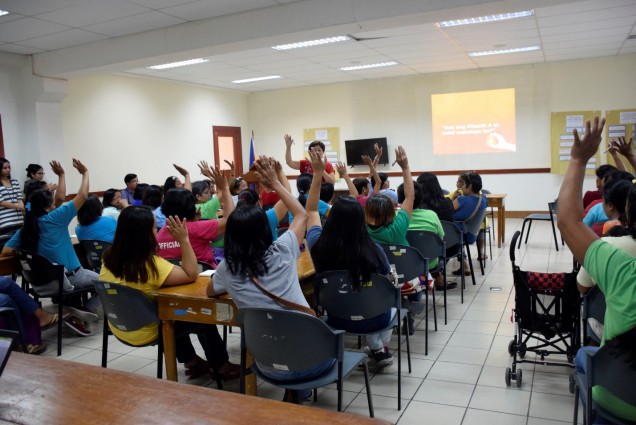
Golden Rice Project briefing in San Mateo Isabela
Rice constitutes a huge portion of a regular diet of every Filipino. On average, a Filipino consumes 114 kilograms of rice every year. Rice, however, does not have much nutrients. It contains largely carbohydrates.
To make it healthier and to help address the pressing malnutrition problem in the country, Golden Rice is being developed. According to Dr. Reynante Ordonio, PhilRice Healthier Rice Project lead, Golden Rice is a new type of rice that contains beta carotene in its grain. He said this nutrient, similar to what is found in orange-colored fruits and vegetables, is converted to vitamin A only as needed by the body.
Ordonio stressed that micronutrient malnutrition, such as vitamin A deficiency (VAD), is a serious public health problem affecting 2 billion people globally. In the Philippines according to the 2013 report of the Food and Nutrition Research Institute (FNRI), 2.1 M children Filipinos aging 6 months to 6 years are affected by VAD. Moreover, the report indicated that 9% of pregnant and 5% of nursing mothers are found to be vitamin A deficient.
While there are government interventions being conducted to address VAD, the problem still persists. Golden Rice, according to Ordonio, is designed as a food-based complementary strategy to help combat VAD.
Currently, the Golden Rice project is undergoing regulatory review for its application to conduct field trials in the Science City of Munoz, Nueva Ecija and San Mateo, Isabela. An important aspect of this review is the public consultation stage where there are discussions and many opinions about Golden Rice are raised. Let’s look at what the stakeholders from these sites have to say.
From the perspective of a mother and a teacher
Fely Urnos is a retired science teacher and a part-time business woman from Brgy. San Andres, San Mateo, Isabela. Ever since her teaching days, she has been actively participating in different organizations in their community such as the Local Council of Women (LCW), Rural Improvement Club (RIC), and groups under the supervision of their parish.
The first time she heard about the Golden Rice project was during the public consultation she attended last July 18. Upon learning about the current issue on VAD, she immediately became alarmed and concerned not only for her family but even for the other children in their community. Fely also considers the number of children and women whose life are at risk because of VAD.
“VAD is really an urgent concern especially since many children and mothers are at risk. Considering the VAD issue and the kind of lifestyle that we have now, we really need to go the extra mile to make sure that everyone has an adequate supply of Vit. A,” Fely expressed.
The pressing issue on VAD became her take off point to support the Golden Rice project. From her perspective as a biology teacher, Fely recognizes the potential of Golden Rice in addressing malnutrition and related diseases. Moreover, she believes that the deficiency of micronutrients, especially Vit. A, can hinder the youth from achieving their full potential.
According to Fely, her support for the Golden Rice project and other research initiatives that aim to solve the country’s pressing health concerns is her way of helping marginalized Filipino women and children to achieve a healthier, better life. As a mother and a homemaker, it gives her relief knowing that Golden Rice has complied with a rigorous biosafety regulatory process.
“Golden rice is one way to address the growing concern on VAD and we should not deprive pregnant women and children of this promising solution. What kind of children are we going to raise if they are deficient of the micronutrients they need? Now, we are being offered with a solution through Golden Rice and I think we should give it a chance,” she emphasizes.
Time to express support
More than expressing her support, Fely is also actively enjoining different stakeholders to view the Golden Rice research from a scientific perspective and continuously seek information from valid sources to avoid misconceptions. For her, learning about Golden Rice allows her to refresh the enthusiasm she has for science and biotechnology.
As science teacher for 40 years, she has already proven the importance of viewing things in an empirical and scientific way. For Fely, what the public needs is a massive information dissemination about Golden Rice so that they, themselves, can make meaningful decisions about it. This specific strategy is what she uses in convincing her groups, and fellow citizens in San Mateo to support the Golden Rice field trial in their town.
“The research on Golden Rice is a noble project and as a citizen of San Mateo, I firmly believe that this should continue to field trial. We have to open our minds and accept technologies like these so that we can continue to provide for the growing population and move forward,” Fely shares.
Fely is just one of the hopeful mothers and homemakers who dream to see their children and grandchildren achieve a bright and a healthy future. She believes that it can only be possible if these children will have access to food that can provide them the right nutrition and micronutrients that they need. Allowing the Golden Rice field trial is a step closer to this dream.
“Most of us support other science and technology initiatives. Let’s do the same for Golden Rice,” Fely ends.




